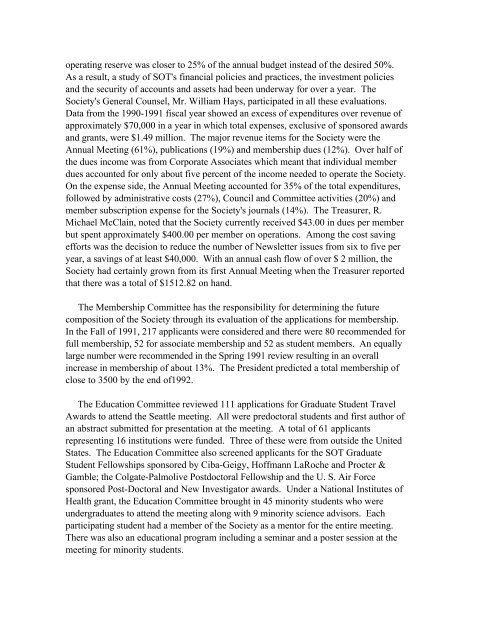SOCIETY O. TOXICOLOGY HISTORY - Society of Toxicology
SOCIETY O. TOXICOLOGY HISTORY - Society of Toxicology
SOCIETY O. TOXICOLOGY HISTORY - Society of Toxicology
You also want an ePaper? Increase the reach of your titles
YUMPU automatically turns print PDFs into web optimized ePapers that Google loves.
operating reserve was closer to 25% <strong>of</strong> the annual budget instead <strong>of</strong> the desired 50%.<br />
As a result, a study <strong>of</strong> SOT's financial policies and practices, the investment policies<br />
and the security <strong>of</strong> accounts and assets had been underway for over a year. The<br />
<strong>Society</strong>'s General Counsel, Mr. William Hays, participated in all these evaluations.<br />
Data from the 1990-1991 fiscal year showed an excess <strong>of</strong> expenditures over revenue <strong>of</strong><br />
approximately $70,000 in a year in which total expenses, exclusive <strong>of</strong> sponsored awards<br />
and grants, were $1.49 million. The major revenue items for the <strong>Society</strong> were the<br />
Annual Meeting (61%), publications (19%) and membership dues (12%). Over half <strong>of</strong><br />
the dues income was from Corporate Associates which meant that individual member<br />
dues accounted for only about five percent <strong>of</strong> the income needed to operate the <strong>Society</strong>.<br />
On the expense side, the Annual Meeting accounted for 35% <strong>of</strong> the total expenditures,<br />
followed by administrative costs (27%), Council and Committee activities (20%) and<br />
member subscription expense for the <strong>Society</strong>'s journals (14%). The Treasurer, R.<br />
Michael McClain, noted that the <strong>Society</strong> currently received $43.00 in dues per member<br />
but spent approximately $400.00 per member on operations. Among the cost saving<br />
efforts was the decision to reduce the number <strong>of</strong> Newsletter issues from six to five per<br />
year, a savings <strong>of</strong> at least $40,000. With an annual cash flow <strong>of</strong> over $ 2 million, the<br />
<strong>Society</strong> had certainly grown from its first Annual Meeting when the Treasurer reported<br />
that there was a total <strong>of</strong> $1512.82 on hand.<br />
The Membership Committee has the responsibility for determining the future<br />
composition <strong>of</strong> the <strong>Society</strong> through its evaluation <strong>of</strong> the applications for membership.<br />
In the Fall <strong>of</strong> 1991, 217 applicants were considered and there were 80 recommended for<br />
full membership, 52 for associate membership and 52 as student members. An equally<br />
large number were recommended in the Spring 1991 review resulting in an overall<br />
increase in membership <strong>of</strong> about 13%. The President predicted a total membership <strong>of</strong><br />
close to 3500 by the end <strong>of</strong>1992.<br />
The Education Committee reviewed 111 applications for Graduate Student Travel<br />
Awards to attend the Seattle meeting. All were predoctoral students and first author <strong>of</strong><br />
an abstract submitted for presentation at the meeting. A total <strong>of</strong> 61 applicants<br />
representing 16 institutions were funded. Three <strong>of</strong> these were from outside the United<br />
States. The Education Committee also screened applicants for the SOT Graduate<br />
Student Fellowships sponsored by Ciba-Geigy, H<strong>of</strong>fmann LaRoche and Procter &<br />
Gamble; the Colgate-Palmolive Postdoctoral Fellowship and the U. S. Air Force<br />
sponsored Post-Doctoral and New Investigator awards. Under a National Institutes <strong>of</strong><br />
Health grant, the Education Committee brought in 45 minority students who were<br />
undergraduates to attend the meeting along with 9 minority science advisors. Each<br />
participating student had a member <strong>of</strong> the <strong>Society</strong> as a mentor for the entire meeting.<br />
There was also an educational program including a seminar and a poster session at the<br />
meeting for minority students.
















